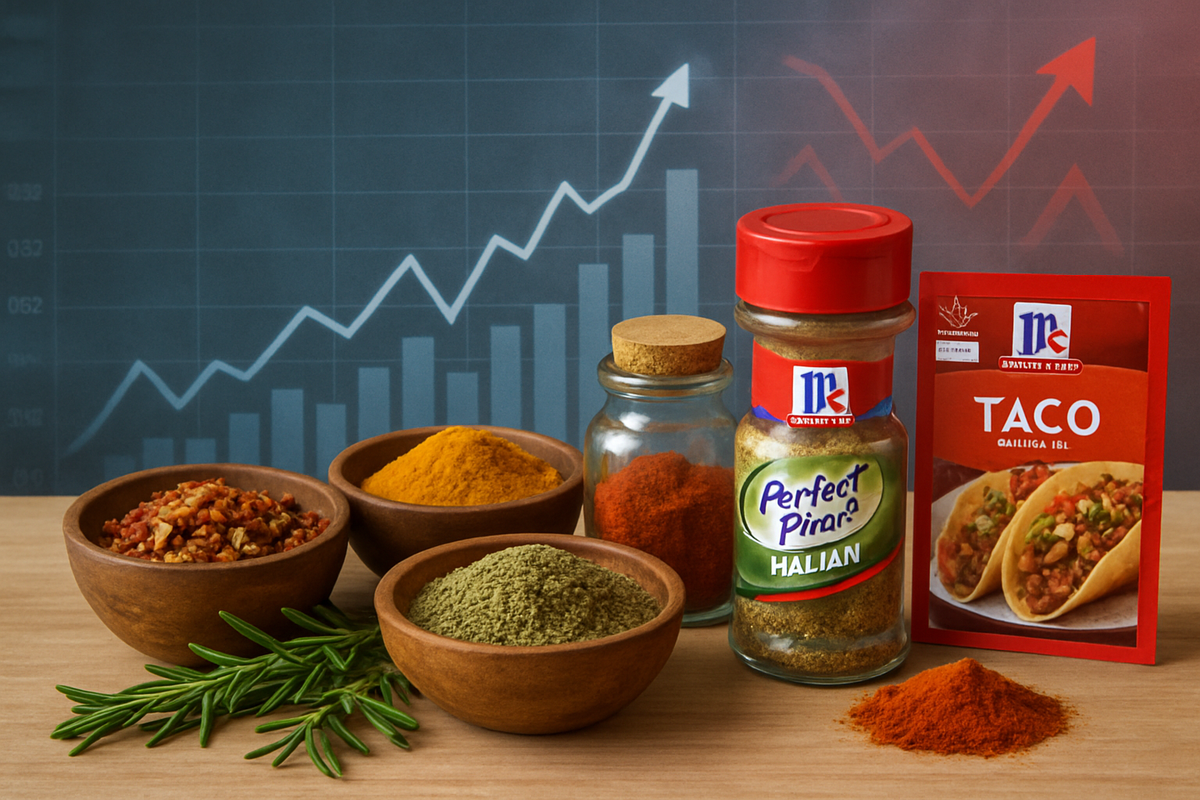
McCormick & Co Inc. (NYSE: MKC) delivered a stronger-than-anticipated performance in its third quarter of fiscal year 2025, with the earnings call held on Tuesday, October 7, 2025, revealing the spice and flavor giant's ability to drive organic sales growth despite a challenging inflationary environment. The company reported adjusted earnings per share (EPS) and revenue that surpassed analyst expectations, signaling resilience in its core business. However, increased projections for tariff and commodity costs have prompted a slight revision in its full-year guidance, underscoring the persistent pressures facing the food industry.
The immediate implications for McCormick are a testament to its brand strength and consumer demand, particularly in its Global Consumer segment, which saw volume-led organic sales growth. While the market's initial reaction appears cautiously optimistic, the revised cost outlook highlights the ongoing balancing act required to maintain profitability amidst global supply chain complexities and rising input expenses. Investors are now closely scrutinizing how the company plans to mitigate these headwinds in the coming quarters.
Q3 2025: A Deep Dive into McCormick's Performance
McCormick's Q3 2025 earnings call, held on October 7, 2025, unveiled a mixed yet largely positive financial picture. The company reported adjusted EPS of $0.85, comfortably exceeding the Zacks Consensus Estimate of $0.81 and a slight increase from the $0.83 reported in the prior-year period. Revenue also outperformed, reaching $1.72 billion against Street forecasts of $1.71 billion, marking a 2.7% rise from Q3 2024. Net income for the quarter stood at $225.5 million, or $0.84 per share.
A significant highlight was the 2% increase in total organic sales, primarily propelled by volume expansion within the Global Consumer segment. This growth was particularly evident in core categories across key markets in the Americas and EMEA, demonstrating sustained consumer demand for McCormick's diverse product portfolio. The Asia Pacific region also contributed positively, with the China retail business continuing its growth trajectory, although the foodservice arm within China experienced softer demand.
Despite these gains, the earnings call brought into focus the escalating cost pressures. Management disclosed that the expected gross tariff costs for fiscal 2025 have been revised upwards to approximately $70 million, a substantial increase from the previously projected $50 million. These tariff and higher commodity costs are now anticipated to exert a more significant drag on the company's profitability, leading to a slight lowering of the full-year adjusted operating income and adjusted EPS guidance. This strategic adjustment reflects the volatile global economic landscape and the complexities of managing a vast supply chain.
The market's initial reaction to the earnings report has been nuanced. While the positive earnings surprise offered some immediate support, analysts have expressed a mixed outlook, with some adjusting price targets downwards. Year-to-date, McCormick's stock has underperformed the S&P 500, indicating that while the Q3 results are encouraging, the broader economic environment and cost challenges remain a concern for investors. The company's proactive communication regarding cost headwinds, however, provides transparency for stakeholders.
Industry Players Face Similar Headwinds and Opportunities
McCormick's Q3 2025 performance, particularly its navigation of rising costs and focus on the consumer segment, provides a crucial benchmark for other public companies in the food and beverage sector. Companies like General Mills (NYSE: GIS), Conagra Brands (NYSE: CAG), and Kraft Heinz Company (NASDAQ: KHC) are likely observing McCormick's strategies closely. Those with strong brand portfolios and efficient supply chains, similar to McCormick's, may be better positioned to pass on cost increases to consumers or absorb them through operational efficiencies. Conversely, companies heavily reliant on highly volatile agricultural commodities without the pricing power of established brands might face more significant margin compression.
The emphasis on volume-led growth in McCormick's consumer segment underscores a broader trend where consumers, despite inflationary pressures, are demonstrating a willingness to prioritize trusted brands for essential pantry items. This could benefit companies with a strong retail presence and diverse product offerings in categories like spices, condiments, and packaged foods. However, the softer demand noted in China's high-end dining foodservice segment could signal a cautious outlook for companies with significant exposure to discretionary out-of-home consumption, potentially impacting restaurant suppliers and premium food manufacturers.
Furthermore, agricultural commodity suppliers and traders are directly impacted by the cost pressures articulated by McCormick. Companies involved in the production and distribution of raw materials like herbs, spices, and other food ingredients will find increased demand from large buyers like McCormick, but also face the challenge of managing their own input costs. The rising tariff costs, specifically mentioned by McCormick, could also shift sourcing strategies, potentially benefiting suppliers in regions not subject to these tariffs, while creating challenges for those in affected areas. This dynamic could lead to shifts in global trade flows for agricultural goods.
Ultimately, companies that can innovate in product offerings, optimize their supply chains to mitigate cost volatility, and maintain strong brand loyalty in the face of price increases are poised to win. Those that struggle with these aspects, particularly in passing on higher costs or maintaining consumer relevance, may see their market share and profitability erode. McCormick's approach of driving volume while managing increased tariffs and commodity expenses will serve as a case study for the entire industry in the coming quarters.
Broader Implications: Inflation, Supply Chains, and Consumer Behavior
McCormick's Q3 2025 earnings report is more than just a snapshot of a single company's performance; it's a significant indicator of broader industry trends and the ongoing challenges within the global economy. The persistent issue of rising costs, particularly agricultural commodities and tariffs, reflects the continued inflationary environment that has gripped economies worldwide. This event underscores how geopolitical factors and supply chain disruptions continue to translate into higher operating expenses for even the most established consumer goods companies. The upward revision of tariff cost projections by McCormick highlights the unpredictable nature of international trade policies and their direct impact on corporate bottom lines.
The company's success in achieving volume-led organic sales growth in its consumer segment also sheds light on evolving consumer behavior. Despite higher prices, consumers are demonstrating a willingness to continue purchasing essential food items and trusted brands, suggesting a degree of inelasticity in demand for these categories. However, the observed slowdown in China's high-end foodservice sector indicates that discretionary spending, particularly in certain channels, remains vulnerable. This dichotomy suggests a tightening of household budgets in some areas while staples maintain their resilience, forcing companies to carefully segment their market strategies.
Potential ripple effects extend to various sectors. For agricultural markets, sustained demand from major food processors like McCormick, coupled with their cost concerns, could lead to continued upward pressure on commodity prices. This, in turn, impacts farmers, processors, and traders across the supply chain. From a regulatory standpoint, the increased tariff costs could reignite discussions around trade agreements and protectionist policies, potentially leading to new negotiations or adjustments that could either alleviate or exacerbate future cost pressures for multinational corporations. Historically, periods of high inflation have always challenged companies to innovate in cost management and pricing strategies, and McCormick's current approach mirrors these past adaptations, emphasizing efficiency and brand value.
This situation also spotlights the critical importance of robust and diversified supply chains. Companies that have invested in resilient sourcing strategies and can quickly adapt to regional disruptions or cost increases will be better positioned. McCormick's experience serves as a reminder that while global sourcing offers advantages, it also exposes companies to a complex web of geopolitical risks and economic volatilities that necessitate continuous strategic review and adaptation.
The Road Ahead: Adaptation and Strategic Pivots
Looking ahead, McCormick & Co Inc. faces a dynamic environment that will necessitate strategic pivots and adaptations to ensure sustained growth and profitability. In the short term, the company will likely focus on aggressive cost management initiatives, including supply chain optimization, procurement efficiencies, and potentially selective price adjustments where market conditions allow without significant volume erosion. The revised full-year guidance for adjusted operating income and EPS indicates that these efforts are already underway, but their effectiveness in mitigating the rising tariff and commodity costs will be crucial.
Long-term possibilities for McCormick include further diversification of its sourcing footprint to reduce reliance on regions prone to high tariffs or volatile commodity prices. Investments in agricultural technology and sustainable farming practices could also become more prominent, not only to secure supply but also to manage costs and meet evolving consumer demands for ethical sourcing. The company may also explore strategic acquisitions or partnerships that enhance its portfolio in resilient categories or expand its presence in high-growth markets, while divesting from underperforming or high-cost segments.
Market opportunities may emerge from continued consumer demand for convenient, flavorful, and health-conscious food solutions, areas where McCormick already has a strong presence. Innovation in product development, particularly in spices, seasonings, and flavor solutions for both consumer and industrial segments, could unlock new revenue streams. However, challenges include intensified competition, potential shifts in consumer preferences towards private labels if inflation persists, and the ongoing need to manage geopolitical risks affecting global supply chains.
Potential scenarios and outcomes range from a successful navigation of cost pressures leading to a rebound in investor confidence and stock performance, to a prolonged period of margin compression if cost mitigation strategies prove insufficient or if global economic headwinds intensify. The company's ability to maintain its brand premium and effectively communicate value to consumers will be paramount. Investors should watch for further updates on cost management initiatives, pricing strategies, and any adjustments to long-term growth forecasts.
Key Takeaways and Future Outlook
McCormick & Co Inc.'s Q3 2025 earnings call underscores a resilient company successfully navigating a challenging economic landscape marked by persistent inflation and rising input costs. The key takeaway is McCormick's ability to achieve volume-led organic sales growth in its Global Consumer segment, demonstrating the enduring strength of its brands and consumer loyalty, even as it grapples with increased tariff and commodity expenses. While the company's financial results surpassed analyst expectations, the upward revision of expected cost headwinds for the full year highlights the ongoing pressure on profitability within the food industry.
Moving forward, the market will closely assess McCormick's strategic execution in mitigating these cost pressures. Its approach to supply chain optimization, potential pricing adjustments, and continued product innovation will be critical in maintaining its competitive edge. The performance of its various segments, particularly the recovery in certain foodservice channels and sustained growth in key consumer markets, will also be vital indicators of its overall health.
Investors should watch for McCormick's ability to maintain gross margins in the face of rising costs, its capital allocation strategies including dividends and share repurchases, and any further updates on its long-term growth initiatives. The broader implications for the market suggest that companies with strong brand equity and agile supply chains are better positioned to weather inflationary storms, but all players must remain vigilant against geopolitical shifts and evolving consumer spending patterns. McCormick's Q3 2025 report serves as a compelling case study of a major food company adapting to the complexities of the current global economy.
This content is intended for informational purposes only and is not financial advice






